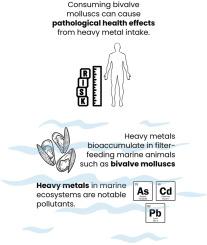Human exposure to heavy metals and possible public health risks via consumption of mussels M. galloprovincialis from the Albanian sea cost
IF 8.1
2区 环境科学与生态学
Q1 ENVIRONMENTAL SCIENCES
引用次数: 0
Abstract
Heavy metals in the marine environment are significant contaminants that readily bioaccumulate in the tissues of aquatic organisms, particularly in filter-feeding animals such as bivalve molluscs. Human exposure to elevated concentrations of heavy metals, including essential elements such as Fe, Cu, and Zn, through the consumption of seafood can lead to various pathological effects. Research has demonstrated that among bivalve molluscs, mussels are the most effective indicators for monitoring marine pollution. Consequently, this study focused on the species Mytilus galloprovincialis to evaluate the levels of Al, As, Cd, Cr, Cu, Fe, Mg, Ni, Pb, and Zn in the two primary harvesting areas of Albania and to assess the associated human health risks from mussel consumption. The results revealed a concerning situation, particularly for Pb and Cd, with average concentrations of 2.15 μg/g and 4.14 μg/g, respectively, significantly exceeding the limits established by Regulation (EC) No. 915/2023. The levels of the other investigated elements also raised concerns, as only half of them were within the dietary intake values recommended by scientific authorities for weekly consumption of 250 g of mussels.

人类通过食用阿尔巴尼亚海域的贻贝 M. galloprovincialis 接触重金属并可能对公共健康造成危害。
海洋环境中的重金属是一种重要的污染物,很容易在水生生物的组织中进行生物累积,尤其是在双壳软体动物等滤食性动物体内。人类通过食用海产品接触高浓度的重金属,包括铁、铜和锌等必需元素,会导致各种病理效应。研究表明,在双壳类软体动物中,贻贝是监测海洋污染最有效的指标。因此,本研究以贻贝为重点,评估阿尔巴尼亚两个主要捕捞区的铝、砷、镉、铬、铜、铁、镁、镍、铅和锌含量,并评估食用贻贝对人类健康造成的相关风险。结果显示,情况令人担忧,尤其是铅和镉,平均浓度分别为 2.15 μg/g 和 4.14 μg/g,大大超出了第 915/2023 号法规(EC)规定的限值。其他调查元素的含量也引起了人们的关注,因为其中只有一半在科学权威机构建议的每周食用 250 克贻贝的膳食摄入值范围内。
本文章由计算机程序翻译,如有差异,请以英文原文为准。
求助全文
约1分钟内获得全文
求助全文
来源期刊

Chemosphere
环境科学-环境科学
CiteScore
15.80
自引率
8.00%
发文量
4975
审稿时长
3.4 months
期刊介绍:
Chemosphere, being an international multidisciplinary journal, is dedicated to publishing original communications and review articles on chemicals in the environment. The scope covers a wide range of topics, including the identification, quantification, behavior, fate, toxicology, treatment, and remediation of chemicals in the bio-, hydro-, litho-, and atmosphere, ensuring the broad dissemination of research in this field.
 求助内容:
求助内容: 应助结果提醒方式:
应助结果提醒方式:


